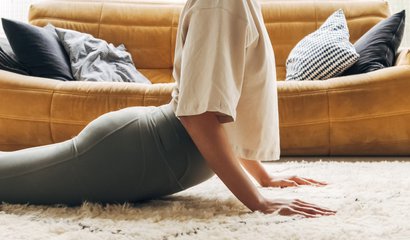Nov. 29, 2017
Movement Monday! When in doubt, stick your butt out
Are you a pelvis tucker? A tucked pelvis seems to be an epidemic these days. Next time you are in a public place, I encourage you to look around (no judgments, just with a curious eye) and see how people are standing. You will likely notice that many people will have their pelvis forward toward their toes and have a flat looking butt with little or no curve in their lumbar spine.
Are you a pelvis tucker? A tucked pelvis seems to be an epidemic these days. Next time you are in a public place, I encourage you to look around (no judgments, just with a curious eye) and see how people are standing. You will likely notice that many people will have their pelvis forward toward their toes and have a flat looking butt with little or no curve in their lumbar spine.
There are many reasons why a tucked pelvis is so prevalent, and a lot of it has to do with wearing shoes with any sort of a heel as it pushes your pelvis forward, causing the knees to bend slightly, therefore shorting your hamstrings which can then pull your pelvis into a posterior tuck (see image above). And sitting! If you sit a lot everyday, especially if you sit on your sacrum (instead of those sit bones) that will shorten the hamstrings. And for years it has been taught in many fitness settings to tuck the tailbone as well. Sigh.
When we have a chronically tucked pelvis, we often end up losing mobility in the hip joints. And when there is poor mobility in the hip joints, we end up using other body parts to compensate to do the moving that the hips were supposed to do. For example, when bending down to pick something off the floor, most people will move down from some combination of the thoracic spine (upper back) and lumbar spine (lower back) creating a C curve in the spine and adding unnecessary strain to the back. This C curve ends up casting our torso into one big body part, usually all moving together instead of being able to move from separate parts as we explored in last week's Movement Mondays. Click here to watch a great little video tutorial about this.
When you have a tucked pelvis and rounded spine, your glutes (your butt muscles) end up turning off. They no longer get to do their job of helping to hold you up. To prevent a flat butt (as in the first picture) and to keep your glutes strong and happy, when standing, back your hips up so that you are standing with your pelvis over your heels. It may feel like you are sticking your butt out, but you are simply feeling the healthy alignment of your hips and legs and your glutes doing what they were born to do. My favourite saying is "when in doubt, stick your butt out!'
Think about this in everyday movement. Think about how often during the day you bend down to pick something off the ground and how often that movement is an unconscious one. How do you move when you aren't thinking about it? That is your movement habit. Take a moment and step away from the computer. Bend down to pick something up. How are you moving? Where do you feel most of the bend coming from? Now try it in front of a mirror. Don't try to move in a "good" way, just do without thinking too much about it and see where you habitually move from in your spine.
Now let's explore how to bend down in a more functional and healthy way to keep your back happy, hip joints mobile and posterior leg muscles long and strong.
How to:
- Stand with your feet pelvis width apart. Take your hands onto your pelvis and use your fingers to feel the bones of your pelvis.
- Keeping your hands on the bones of your pelvis, back your pelvis so that it is over your heels.
- Stick your butt out and start to tilt down from the pelvis like a hinge until you feel the pelvis stop moving.
- Take one hand to your lower back and see if you still have your lumbar curve. If not, and the low back feels rounded in a tuck, bring your torso up a little higher until you can find your lumbar spine.
- Keep your low ribs in to support your core and spine.
- Stay here for a few breaths to awaken your hamstrings both in creating length and strength.
- Inhale and tilt your pelvis up like a hinge to bring your spine back upright.
CHECK OUT THE SHAPE OF MY SPINE IN THIS BEND. IT IS ALL CURVED AS ONE BIG C CURVE WITH THAT TUCKED PELVIS. I ALSO HAVE MORE WEIGHT ON ONE LEG THAN THE OTHER.
BY BACKING MY HIPS UP, UNTUCKING MY PELVIS, MY LEGS ARE STRONG AND MY SPINE IS HAPPY. HURRAY!
BRINGING THIS INTO YOUR EVERYDAY
If you have tight hamstrings, after doing the hip hinge movement you will notice that your pelvis didn't move down too far. Which means if you were to pick something up off the ground, you would be a long way from reaching it. Here are some other options. The main goal is to shift out of your habitual way of moving and get your pelvis to be what initiates the forward bending. That little change at the start of your movement can make a big difference.
- Start your bend from the pelvis, when it stops moving you can allow the rest of the spine to bend down and bring you closer to the floor.
- Or start your bend from the pelvis and this time when it stops moving, shift your hips back a little more so your glutes can help hold you up, and bend your knees to get down closer to the floor. Just try to keep your butt back, and knees over the ankles as best you can.
Remember a big part of the lack of actual hip hinge is because the hamstrings are so tight. But don't let tight hamstrings stop you from changing your movement habits. Check out these tips:






